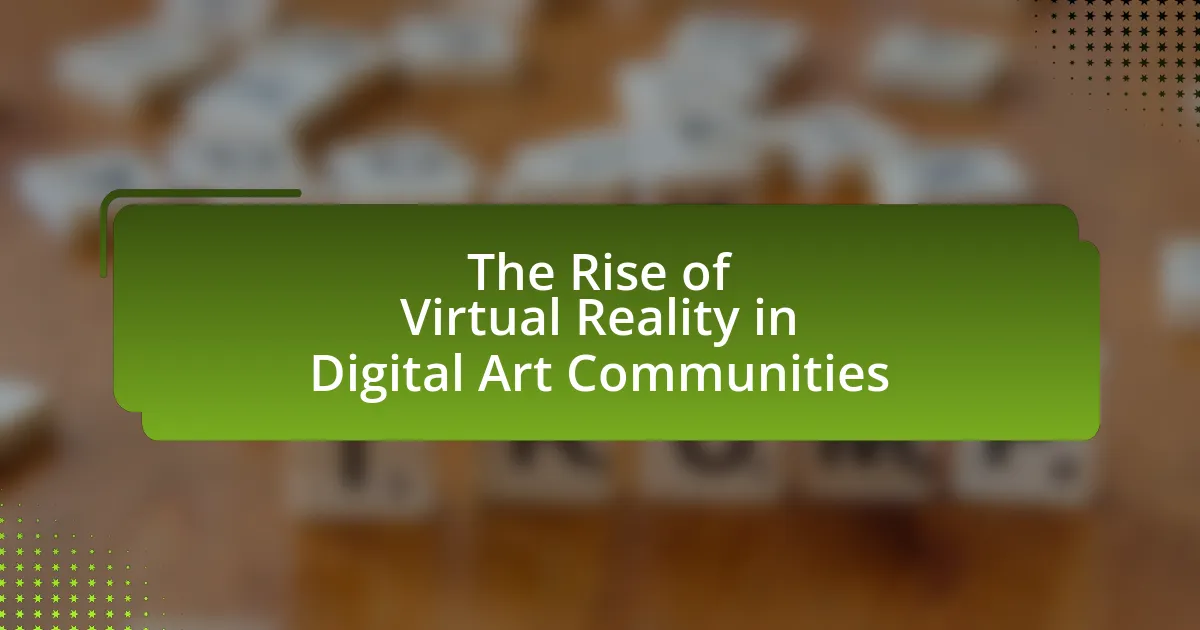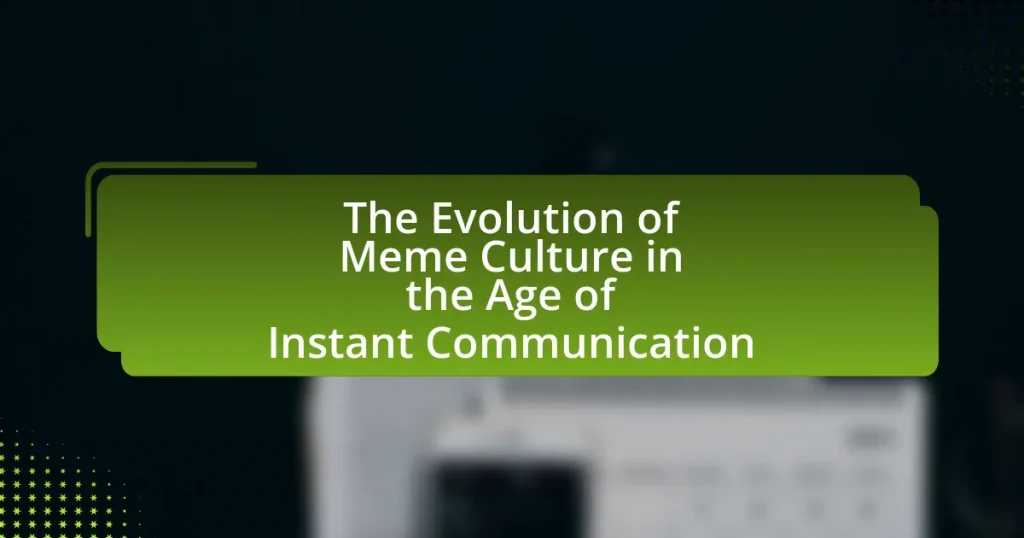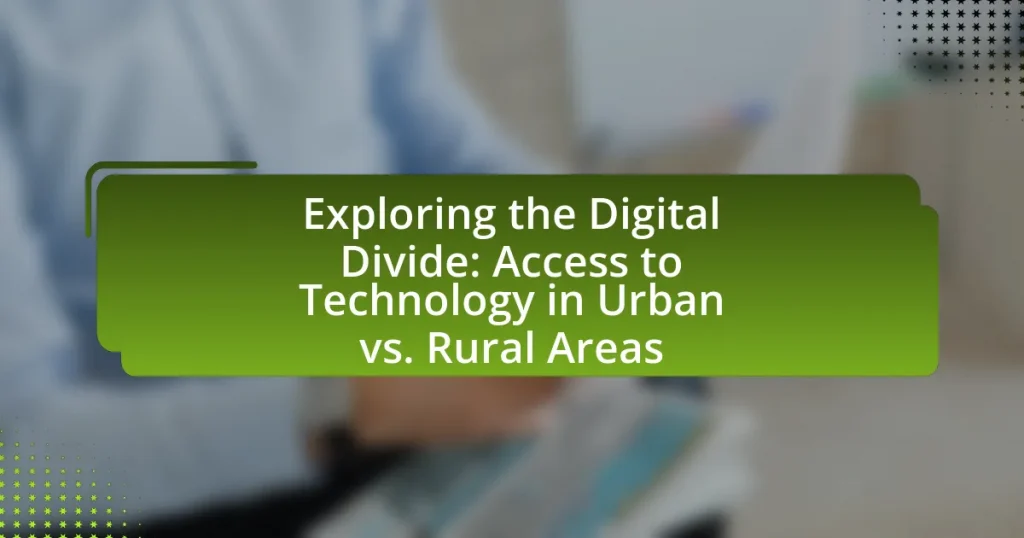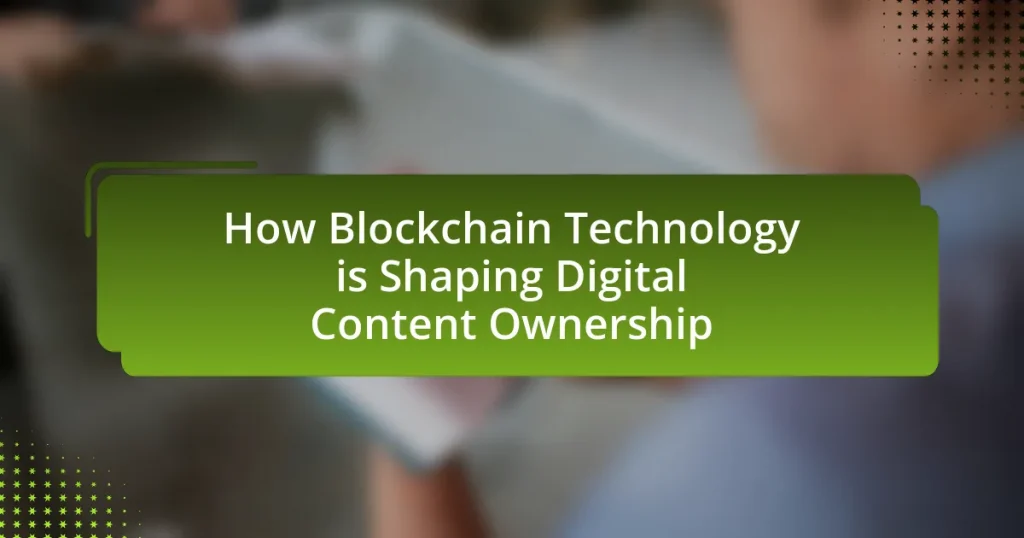The article examines the rise of virtual reality (VR) in digital art communities, highlighting how immersive technologies are transforming artistic creation and audience engagement. It discusses the tools and platforms driving this transformation, such as Oculus Medium and Tilt Brush, which enable artists to create and manipulate 3D art in real-time. The article also addresses the challenges artists face, including technical limitations and the learning curve associated with VR, while emphasizing the growing popularity of VR art exhibitions and collaborative projects. Additionally, it explores the impact of social media on the visibility of VR art and outlines key trends shaping the future of digital art in virtual environments.

What is the Rise of Virtual Reality in Digital Art Communities?
The rise of virtual reality in digital art communities refers to the increasing integration of immersive technologies that allow artists and audiences to experience and interact with art in three-dimensional spaces. This trend has been facilitated by advancements in VR technology, making it more accessible and affordable for creators and consumers alike. For instance, platforms like Oculus Medium and Tilt Brush enable artists to create and manipulate 3D art in real-time, fostering innovative artistic expressions. Additionally, a report by the International Data Corporation (IDC) projected that the global VR market would reach $12 billion by 2024, indicating a growing interest and investment in VR applications, including digital art. This shift not only enhances the creative process but also transforms how art is exhibited and experienced, allowing for virtual galleries and interactive installations that engage a broader audience.
How has virtual reality transformed digital art creation?
Virtual reality has transformed digital art creation by enabling immersive, interactive environments where artists can create and manipulate three-dimensional artworks. This technology allows artists to visualize their creations in a spatial context, enhancing the depth and realism of their work. For instance, platforms like Tilt Brush and Oculus Medium provide tools that let artists paint in a 3D space, offering a new dimension to artistic expression that traditional digital art tools cannot replicate. Additionally, virtual reality facilitates collaboration among artists across the globe, allowing them to work together in shared virtual spaces, which fosters innovation and community engagement in the digital art scene.
What tools and technologies are driving this transformation?
Virtual reality (VR) headsets, software platforms, and immersive tools are driving the transformation in digital art communities. VR headsets like Oculus Rift and HTC Vive provide artists with immersive environments to create and interact with their art in three-dimensional space. Software platforms such as Tilt Brush and Oculus Medium enable users to paint and sculpt in virtual reality, enhancing creativity and collaboration. Additionally, technologies like augmented reality (AR) and mixed reality (MR) are increasingly integrated into these platforms, allowing for a blend of digital and physical art experiences. The adoption of these tools has led to a significant increase in community engagement and artistic expression within digital art spaces.
How do artists adapt their techniques for virtual reality?
Artists adapt their techniques for virtual reality by utilizing immersive tools and software that allow for three-dimensional creation and interaction. They often shift from traditional two-dimensional mediums to three-dimensional environments, employing software like Tilt Brush or Oculus Medium to create art that can be experienced from multiple angles. This adaptation requires artists to rethink spatial relationships and viewer engagement, as VR art is designed to be explored rather than simply viewed. Additionally, artists incorporate interactive elements, enabling users to influence the artwork, which enhances the immersive experience. This evolution in technique reflects the growing demand for innovative forms of expression within digital art communities, as evidenced by the increasing number of VR art exhibitions and collaborations among artists and technologists.
Why is virtual reality gaining popularity among digital artists?
Virtual reality is gaining popularity among digital artists because it offers immersive experiences that enhance creativity and interactivity. This technology allows artists to create and manipulate 3D environments in real-time, providing a unique platform for artistic expression that traditional mediums cannot match. According to a report by the International Data Corporation, the global virtual reality market is expected to grow significantly, indicating a rising interest and investment in VR technologies. Additionally, platforms like Tilt Brush and Oculus Medium have made it easier for artists to experiment with new forms and techniques, further driving the adoption of virtual reality in the digital art community.
What unique experiences does virtual reality offer to artists?
Virtual reality offers artists immersive environments that enable them to create and interact with their artwork in three-dimensional space. This technology allows artists to visualize their creations from multiple perspectives, enhancing their creative process and enabling a more intuitive approach to art-making. For instance, platforms like Tilt Brush allow artists to paint in a virtual space, providing a unique experience that traditional mediums cannot replicate. Additionally, virtual reality facilitates collaboration among artists across the globe, allowing them to share and co-create in real-time, which fosters community and innovation within digital art communities.
How does virtual reality enhance collaboration in art communities?
Virtual reality enhances collaboration in art communities by providing immersive environments where artists can interact, create, and share their work in real-time. This technology allows multiple users to enter a shared virtual space, facilitating direct communication and collaboration regardless of geographical barriers. For instance, platforms like VRChat and Spatial enable artists to showcase their creations, receive instant feedback, and co-create artworks, thereby fostering a sense of community and collective creativity. Studies have shown that such immersive experiences can lead to increased engagement and innovation among participants, as they can visualize and manipulate 3D art in ways that traditional media cannot offer.
What challenges do artists face when using virtual reality?
Artists face several challenges when using virtual reality, including technical limitations, high costs, and a steep learning curve. Technical limitations often involve hardware constraints, such as the need for powerful computers and specific VR headsets, which can restrict accessibility. High costs are associated with both the equipment and software required for VR art creation, making it financially prohibitive for many artists. Additionally, the steep learning curve can deter artists unfamiliar with VR technology, as mastering the tools and software can require significant time and effort. These challenges collectively hinder the widespread adoption of virtual reality in digital art communities.
What technical limitations exist in current virtual reality platforms?
Current virtual reality platforms face several technical limitations, including hardware constraints, limited field of view, and latency issues. Hardware limitations often involve the need for high-performance computing power and graphics capabilities, which can restrict accessibility for users with less advanced systems. The field of view in many VR headsets is often narrower than human vision, typically around 100 degrees, which can lead to a less immersive experience. Additionally, latency issues, which can result in motion sickness, occur when there is a delay between user actions and system responses, with acceptable latency being under 20 milliseconds for a comfortable experience. These limitations hinder the overall effectiveness and user experience of virtual reality in digital art communities.
How do artists overcome the learning curve associated with virtual reality?
Artists overcome the learning curve associated with virtual reality by engaging in structured training programs and utilizing online tutorials. These resources provide step-by-step guidance on VR tools and software, enabling artists to familiarize themselves with the technology. Additionally, many artists participate in community forums and workshops, where they can share experiences and learn from peers. Research indicates that hands-on practice and collaboration significantly enhance skill acquisition in new technologies, as seen in studies on digital art education. This combination of formal training, peer support, and practical experience effectively reduces the barriers to mastering virtual reality for artists.
How does virtual reality influence audience engagement in digital art?
Virtual reality significantly enhances audience engagement in digital art by providing immersive experiences that allow viewers to interact with art in a three-dimensional space. This technology enables audiences to explore artworks from various angles and perspectives, fostering a deeper emotional connection and understanding of the pieces. Research indicates that immersive environments can increase user engagement levels by up to 70%, as participants feel more present and involved in the artistic experience. Additionally, virtual reality facilitates social interactions among users, allowing them to share experiences and collaborate in real-time, further enriching the engagement with digital art.
What role do social media and online platforms play in this rise?
Social media and online platforms significantly contribute to the rise of virtual reality in digital art communities by facilitating widespread access and engagement. These platforms enable artists to showcase their VR creations to a global audience, fostering collaboration and inspiration among creators. For instance, platforms like Instagram and YouTube allow artists to share immersive experiences, attracting viewers and potential collaborators. Additionally, social media algorithms promote trending VR content, increasing visibility and encouraging community interaction. According to a report by Statista, as of 2023, over 4.7 billion people use social media worldwide, highlighting its role in connecting artists and audiences, thus accelerating the adoption of virtual reality in digital art.

What are the key trends in virtual reality within digital art communities?
Key trends in virtual reality within digital art communities include increased collaboration among artists, immersive experiences for audiences, and the integration of blockchain technology for digital ownership. Artists are leveraging virtual reality platforms to collaborate in real-time, creating shared spaces where they can experiment and innovate together. Immersive experiences are becoming more prevalent, allowing audiences to engage with art in three-dimensional environments, enhancing emotional connections and interactivity. Additionally, the use of blockchain technology is gaining traction, enabling artists to tokenize their work, ensuring provenance and ownership in the digital realm. These trends reflect a shift towards more interactive, community-driven, and secure practices in digital art.
How are immersive experiences changing the way art is perceived?
Immersive experiences are transforming the perception of art by enabling deeper emotional engagement and interaction with artworks. Traditional art forms often limit viewer interaction to passive observation, whereas immersive experiences, such as virtual reality installations, allow individuals to explore and interact with art in a multi-sensory environment. This shift enhances the viewer’s connection to the artwork, as evidenced by studies showing that participants in immersive art experiences report higher levels of emotional response and personal reflection compared to traditional viewing settings. For instance, a study published in the journal “Computers in Human Behavior” found that immersive environments significantly increased participants’ empathy and emotional engagement with the art, demonstrating a clear impact on how art is experienced and understood.
What are the most popular virtual reality art exhibitions currently?
The most popular virtual reality art exhibitions currently include “The Night Cafe,” “The Infinite Retina,” and “The Virtual Reality Museum of Fine Art.” “The Night Cafe,” inspired by Vincent van Gogh, allows users to explore a 3D recreation of his famous painting, attracting significant attention for its immersive experience. “The Infinite Retina” showcases works by contemporary artists in a surreal, dreamlike environment, gaining popularity for its innovative use of VR technology. “The Virtual Reality Museum of Fine Art” features a collection of classic and modern artworks, enabling visitors to interact with pieces in a virtual space, which has drawn large audiences and critical acclaim. These exhibitions exemplify the growing integration of virtual reality in the art world, enhancing accessibility and engagement for diverse audiences.
How do virtual reality experiences differ from traditional art forms?
Virtual reality experiences differ from traditional art forms primarily in their immersive and interactive nature. Unlike traditional art, which is typically a static visual experience, virtual reality allows users to engage with the artwork in a three-dimensional space, enabling them to explore and manipulate the environment. This interactivity can enhance emotional engagement and personal connection to the art, as users can influence their experience in real-time. For instance, studies have shown that immersive environments can lead to heightened emotional responses, making the experience more impactful compared to viewing a painting or sculpture in a gallery setting.
What innovations are emerging in virtual reality art tools?
Innovations in virtual reality art tools include enhanced collaborative environments, improved haptic feedback systems, and advanced AI-assisted design features. Collaborative environments allow multiple artists to work together in real-time, fostering creativity and interaction, as seen in platforms like Spatial and Mozilla Hubs. Improved haptic feedback systems provide tactile sensations that mimic real-world interactions, enhancing the immersive experience, with companies like HaptX leading in this technology. Additionally, AI-assisted design features streamline the creative process by offering suggestions and automating repetitive tasks, exemplified by tools like Adobe’s Project Aero. These advancements collectively enhance the functionality and user experience of virtual reality art tools, making them more accessible and engaging for artists.
Which software and hardware are leading the market?
The leading software in the virtual reality market includes Unity and Unreal Engine, while the dominant hardware consists of the Meta Quest 2 and Valve Index. Unity and Unreal Engine are widely used for developing immersive VR experiences, with Unity holding a significant market share due to its versatility and user-friendly interface. The Meta Quest 2 is recognized for its affordability and standalone capabilities, making it accessible to a broad audience, while the Valve Index is praised for its high-quality visuals and advanced tracking technology. These software and hardware solutions are pivotal in shaping the virtual reality landscape within digital art communities.
How are artists pushing the boundaries of virtual reality technology?
Artists are pushing the boundaries of virtual reality technology by creating immersive experiences that blend digital art with interactive storytelling. These artists utilize advanced VR tools and platforms, such as Oculus Medium and Tilt Brush, to craft environments that engage users on multiple sensory levels. For instance, projects like “The Night Cafe” by Mac Cauley recreate Vincent van Gogh’s iconic works in a 3D space, allowing users to explore and interact with the art in a way that traditional mediums cannot offer. This innovative approach not only enhances viewer engagement but also expands the definition of art itself, as seen in the rise of virtual exhibitions and collaborative VR art projects that invite participation from global audiences.
What future developments can we expect in virtual reality art communities?
Future developments in virtual reality art communities will likely include enhanced collaborative tools, improved accessibility, and integration of artificial intelligence. Enhanced collaborative tools will allow artists to create and share immersive experiences in real-time, fostering a more interactive environment. Improved accessibility will enable a broader audience to participate, as advancements in hardware and software reduce costs and technical barriers. Integration of artificial intelligence will facilitate personalized art experiences, where AI can assist in the creative process or curate content based on user preferences. These trends are supported by the increasing investment in VR technologies and the growing popularity of virtual art exhibitions, indicating a robust future for virtual reality art communities.
How might virtual reality evolve in the next decade?
Virtual reality is expected to evolve significantly in the next decade through advancements in hardware, software, and user experience. Enhanced graphics and processing power will lead to more immersive environments, allowing users to interact with digital art in ways that feel more natural and engaging. For instance, the introduction of eye-tracking technology and haptic feedback will enable artists and viewers to experience art in a multi-sensory manner, enhancing emotional connections. Additionally, the integration of artificial intelligence will facilitate personalized experiences, tailoring virtual environments to individual preferences and artistic styles. According to a report by Statista, the global virtual reality market is projected to grow from approximately $15 billion in 2020 to over $57 billion by 2027, indicating a strong trend towards increased adoption and innovation in this field.
What potential collaborations could shape the future of digital art?
Collaborations between technology companies, artists, and virtual reality platforms could significantly shape the future of digital art. For instance, partnerships between VR companies like Oculus and artists can lead to immersive art experiences that redefine how audiences interact with art. Additionally, collaborations with blockchain technology can enable artists to tokenize their work, ensuring provenance and creating new revenue streams through NFTs. These collaborations are already evident, as seen in projects like “The Night Cafe,” which utilizes VR to recreate Van Gogh’s famous painting, allowing users to explore the artwork in a three-dimensional space. Such innovative partnerships are likely to drive the evolution of digital art, making it more interactive and accessible.
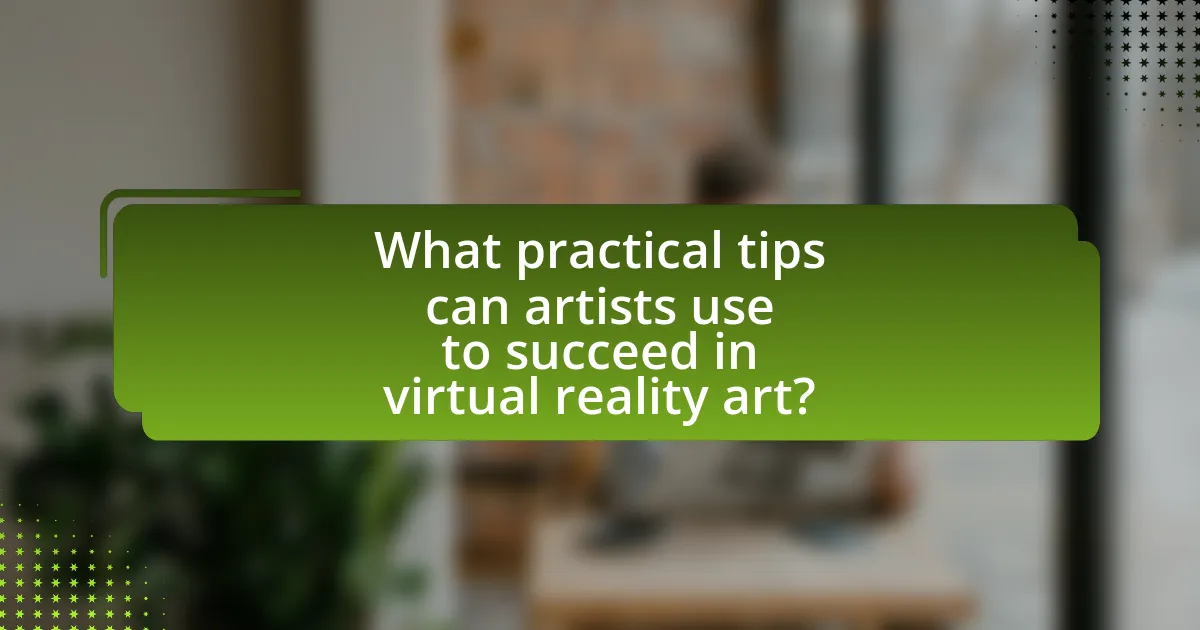
What practical tips can artists use to succeed in virtual reality art?
Artists can succeed in virtual reality art by mastering the technology, engaging with the community, and continuously experimenting with their creative processes. Mastering the technology involves familiarizing oneself with VR tools and software, such as Tilt Brush or Oculus Medium, which are essential for creating immersive experiences. Engaging with the community is crucial; artists should participate in VR art forums, attend virtual exhibitions, and collaborate with other creators to gain visibility and feedback. Continuous experimentation allows artists to push boundaries and innovate, which is vital in a rapidly evolving medium. According to a report by the International Data Corporation, the VR market is expected to grow significantly, indicating a rising demand for skilled VR artists.
How can artists effectively market their virtual reality artworks?
Artists can effectively market their virtual reality artworks by leveraging social media platforms, engaging in virtual exhibitions, and collaborating with influencers in the digital art space. Social media platforms like Instagram and TikTok allow artists to showcase immersive experiences, reaching a wider audience. Virtual exhibitions, such as those hosted on platforms like Spatial or VRChat, provide interactive environments where potential buyers can experience the artwork firsthand. Collaborating with influencers can amplify visibility, as these individuals often have established audiences interested in innovative art forms. According to a report by Art Basel and UBS, online art sales reached $12.4 billion in 2021, highlighting the growing importance of digital marketing strategies in the art world.
What platforms are best for showcasing virtual reality art?
The best platforms for showcasing virtual reality art include Oculus Medium, Tilt Brush, and ArtSteps. Oculus Medium allows artists to sculpt and create in a VR environment, providing tools specifically designed for 3D art creation. Tilt Brush, developed by Google, enables users to paint in a 3D space, offering a unique way to visualize art. ArtSteps is a platform that allows users to create virtual exhibitions, making it easy to showcase VR art to a broader audience. These platforms are widely recognized in the digital art community for their capabilities and user engagement, making them ideal for artists looking to display their virtual reality creations.
How can artists engage with their audience in virtual reality spaces?
Artists can engage with their audience in virtual reality spaces by creating immersive experiences that allow for interactive participation. This engagement can include virtual exhibitions where viewers can explore artworks in a 3D environment, attend live performances, or participate in collaborative art-making sessions. For instance, platforms like VRChat and AltspaceVR enable artists to host events where audiences can interact with the art and each other in real-time, fostering a sense of community. Research indicates that immersive environments can enhance emotional connections to art, as users report higher levels of engagement and satisfaction when experiencing art in virtual reality compared to traditional formats.
What best practices should artists follow when creating in virtual reality?
Artists should prioritize user experience and immersion when creating in virtual reality. This involves designing intuitive interfaces that allow users to navigate and interact seamlessly within the virtual environment. Additionally, artists should consider the spatial dynamics of VR, ensuring that their work takes advantage of 3D space to enhance storytelling and engagement.
Incorporating feedback from users during the development process is crucial, as it helps refine the experience and address any usability issues. Furthermore, artists should stay updated on the latest VR technologies and tools, as advancements can significantly impact the creative process and the final product.
Research indicates that immersive experiences can lead to higher emotional engagement, which is essential for effective storytelling in VR (Slater & Wilbur, 1997). By following these best practices, artists can create compelling and memorable virtual reality experiences that resonate with audiences.
How can artists ensure accessibility in their virtual reality works?
Artists can ensure accessibility in their virtual reality works by incorporating features such as adjustable settings for visual and auditory elements, providing alternative navigation methods, and including descriptive audio or captions. These features allow users with varying abilities to engage with the content effectively. Research indicates that implementing accessibility guidelines, such as those from the Web Content Accessibility Guidelines (WCAG), can significantly enhance user experience for individuals with disabilities. For instance, a study by the University of Washington found that accessible design in VR can improve engagement by up to 30% among users with disabilities.
What are common pitfalls to avoid in virtual reality art creation?
Common pitfalls to avoid in virtual reality art creation include neglecting user experience, failing to optimize for performance, and overlooking the importance of spatial awareness. Neglecting user experience can lead to disorientation and frustration, as users may struggle to navigate or interact with the artwork effectively. Performance optimization is crucial because lag or low frame rates can detract from immersion, making the experience less engaging. Additionally, overlooking spatial awareness can result in artworks that do not utilize the 3D environment effectively, diminishing the impact of the art. These pitfalls can significantly hinder the effectiveness and enjoyment of virtual reality art.
